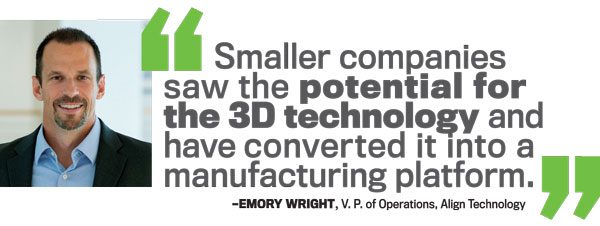CEOs who get the formula right can transform their businesses or create entirely new ones. That’s what Align, based in San Jose, California, has done. It built its business on the back of 3D techniques, reaching the $660 million sales level in its most recent fiscal year. Its products, which it calls aligners, are pieces of clear plastic that a patient wears in the mouth to move teeth into better positions. Over time, as a patient’s teeth shift, he or she gets new aligners that continue the gradual shifting process, perhaps more than a dozen times.
 The company uses technology similar to computer-aided design (CAD) to take pictures of a patient’s mouth, but then it uses an additive manufacturing technique called stereolithography to create molds that are exact replicas of the patient’s teeth. A piece of plastic is thermoformed over the mold, becoming the aligner, and the mold is then thrown away. But the company would not be able to get the accuracy it needs without the step involving 3D.
The company uses technology similar to computer-aided design (CAD) to take pictures of a patient’s mouth, but then it uses an additive manufacturing technique called stereolithography to create molds that are exact replicas of the patient’s teeth. A piece of plastic is thermoformed over the mold, becoming the aligner, and the mold is then thrown away. But the company would not be able to get the accuracy it needs without the step involving 3D.
“Everything we make is different,” says Wright. “When you are making something different every time, additive manufacturing is now a technology that can do that.”
Because Align built its business on the basis of 3D technologies over the past 15 years, it did not have to overcome internal resistance. It’s an example of how small and mid-sized companies, which are not hemmed in by large capital investments that big companies make in plant and equipment, can move faster and disrupt their competitors.
“For a company like GE to make a change in its manufacturing methods, from the traditional to the 3D world, is a big investment, not only in technology but also in people and cultural change,” explains Wright. “But smaller companies saw the potential for the technology like we did and have converted it into a manufacturing platform.” That’s the ultimate payoff for going up the 3D learning curve.
TAKE A PERSONAL INTEREST in 3D technologies that might be relevant to your business. Tap consultants, go to trade shows, visit potential suppliers and in general, demonstrate to your organization that you’re serious. Learn enough to challenge other executives and get them out of their zones of comfort.
TO GET “BUY IN,” seek internal champions to help push 3D and give them time and resources to explore the new technologies.
IF INTERNAL CHAMPIONS are not available, consider consultants, university programs and government programs like America Works or the Ohio Third Frontier program to introduce new ideas into the company and convince internal constituencies that 3D can be transformative. This is called “open innovation.”
DON’T TAKE SUDDEN PLUNGES and buy big pieces of 3D equipment. Start by buying additively made parts and simple machines to speed your company’s learning curve.
BUILD UP THE SKILL SETS of your key employees, such as engineers and machine operators, by encouraging them to take courses at community colleges or other entities that offer 3D training.
Chief Executive Group exists to improve the performance of U.S. CEOs, senior executives and public-company directors, helping you grow your companies, build your communities and strengthen society. Learn more at chiefexecutivegroup.com.
0

1:00 - 5:00 pm
Over 70% of Executives Surveyed Agree: Many Strategic Planning Efforts Lack Systematic Approach Tips for Enhancing Your Strategic Planning Process
Executives expressed frustration with their current strategic planning process. Issues include:
Steve Rutan and Denise Harrison have put together an afternoon workshop that will provide the tools you need to address these concerns. They have worked with hundreds of executives to develop a systematic approach that will enable your team to make better decisions during strategic planning. Steve and Denise will walk you through exercises for prioritizing your lists and steps that will reset and reinvigorate your process. This will be a hands-on workshop that will enable you to think about your business as you use the tools that are being presented. If you are ready for a Strategic Planning tune-up, select this workshop in your registration form. The additional fee of $695 will be added to your total.

2:00 - 5:00 pm
Female leaders face the same issues all leaders do, but they often face additional challenges too. In this peer session, we will facilitate a discussion of best practices and how to overcome common barriers to help women leaders be more effective within and outside their organizations.
Limited space available.

10:30 - 5:00 pm
General’s Retreat at Hermitage Golf Course
Sponsored by UBS
General’s Retreat, built in 1986 with architect Gary Roger Baird, has been voted the “Best Golf Course in Nashville” and is a “must play” when visiting the Nashville, Tennessee area. With the beautiful setting along the Cumberland River, golfers of all capabilities will thoroughly enjoy the golf, scenery and hospitality.
The golf outing fee includes transportation to and from the hotel, greens/cart fees, use of practice facilities, and boxed lunch. The bus will leave the hotel at 10:30 am for a noon shotgun start and return to the hotel after the cocktail reception following the completion of the round.